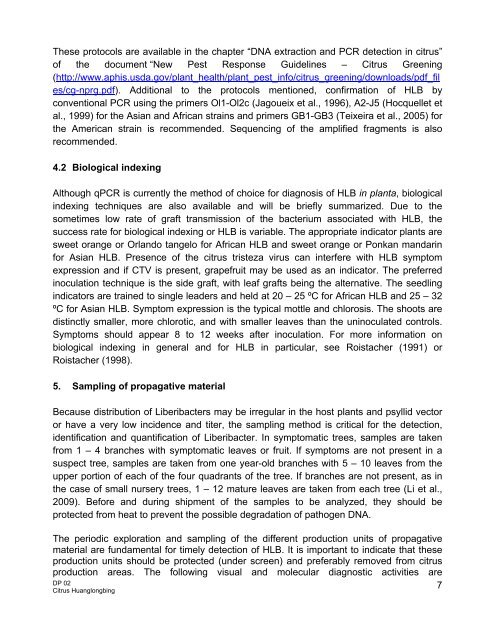NAPPO DIAGNOSTIC PROTOCOLS DP 02 Citrus Huanglongbing
NAPPO DIAGNOSTIC PROTOCOLS DP 02 Citrus Huanglongbing
NAPPO DIAGNOSTIC PROTOCOLS DP 02 Citrus Huanglongbing
You also want an ePaper? Increase the reach of your titles
YUMPU automatically turns print PDFs into web optimized ePapers that Google loves.
These protocols are available in the chapter “DNA extraction and PCR detection in citrus”<br />
of the document “New Pest Response Guidelines – <strong>Citrus</strong> Greening<br />
(http://www.aphis.usda.gov/plant_health/plant_pest_info/citrus_greening/downloads/pdf_fil<br />
es/cg-nprg.pdf). Additional to the protocols mentioned, confirmation of HLB by<br />
conventional PCR using the primers Ol1-Ol2c (Jagoueix et al., 1996), A2-J5 (Hocquellet et<br />
al., 1999) for the Asian and African strains and primers GB1-GB3 (Teixeira et al., 2005) for<br />
the American strain is recommended. Sequencing of the amplified fragments is also<br />
recommended.<br />
4.2 Biological indexing<br />
Although qPCR is currently the method of choice for diagnosis of HLB in planta, biological<br />
indexing techniques are also available and will be briefly summarized. Due to the<br />
sometimes low rate of graft transmission of the bacterium associated with HLB, the<br />
success rate for biological indexing or HLB is variable. The appropriate indicator plants are<br />
sweet orange or Orlando tangelo for African HLB and sweet orange or Ponkan mandarin<br />
for Asian HLB. Presence of the citrus tristeza virus can interfere with HLB symptom<br />
expression and if CTV is present, grapefruit may be used as an indicator. The preferred<br />
inoculation technique is the side graft, with leaf grafts being the alternative. The seedling<br />
indicators are trained to single leaders and held at 20 – 25 ºC for African HLB and 25 – 32<br />
ºC for Asian HLB. Symptom expression is the typical mottle and chlorosis. The shoots are<br />
distinctly smaller, more chlorotic, and with smaller leaves than the uninoculated controls.<br />
Symptoms should appear 8 to 12 weeks after inoculation. For more information on<br />
biological indexing in general and for HLB in particular, see Roistacher (1991) or<br />
Roistacher (1998).<br />
5. Sampling of propagative material<br />
Because distribution of Liberibacters may be irregular in the host plants and psyllid vector<br />
or have a very low incidence and titer, the sampling method is critical for the detection,<br />
identification and quantification of Liberibacter. In symptomatic trees, samples are taken<br />
from 1 – 4 branches with symptomatic leaves or fruit. If symptoms are not present in a<br />
suspect tree, samples are taken from one year-old branches with 5 – 10 leaves from the<br />
upper portion of each of the four quadrants of the tree. If branches are not present, as in<br />
the case of small nursery trees, 1 – 12 mature leaves are taken from each tree (Li et al.,<br />
2009). Before and during shipment of the samples to be analyzed, they should be<br />
protected from heat to prevent the possible degradation of pathogen DNA.<br />
The periodic exploration and sampling of the different production units of propagative<br />
material are fundamental for timely detection of HLB. It is important to indicate that these<br />
production units should be protected (under screen) and preferably removed from citrus<br />
production areas. The following visual and molecular diagnostic activities are<br />
7<br />
<strong>DP</strong> <strong>02</strong><br />
<strong>Citrus</strong> <strong>Huanglongbing</strong>













